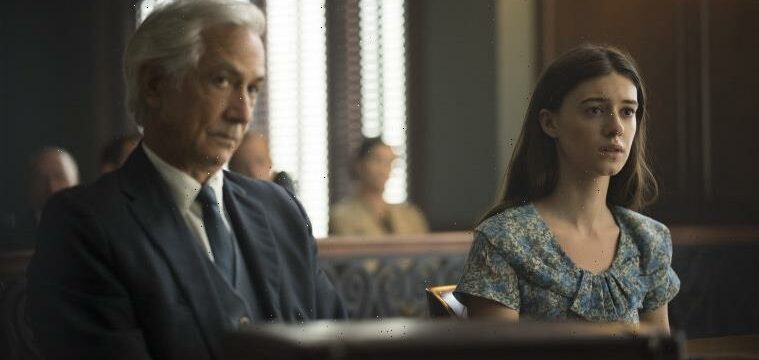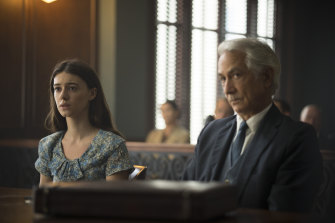WHERE THE CRAWDADS SING
M, 125 minutes. In cinemas July 21
★★★
Delia Owens’ much-loved bestseller, Where the Crawdads Sing, is an artful combination of whodunnit, romance novel and classic fairytale – Snow White with Mother Nature standing in for the dwarves.
Abandoned by her family, Kya Clark grows up alone in a shack in a Carolina salt marsh. Shunned by the neighbourhood’s white population, she survives with the help of a kindly black couple – Jumpin’, the local storekeeper, and his wife, Mabel. And because the taunts of other children make school impossible, the birds, animals and insects of the marshland become her teachers.
But once she grows up, love and sex enter the picture and life becomes complicated.
Daisy Edgar-Jones and David Strathairn in Where the Crawdads Sing.Credit:Michele K. Short/Sony Pictures
Reese Witherspoon co-produced the film of the novel, buying the rights after reading it in manuscript. I must have seemed irresistible, incorporating a crowd-pleasing plot with a seductively distinctive setting. Better still, the book is elevated beyond potboiler standard by Owens’ prose.
Trained as a zoologist, she depicts the moods of the marsh and the creatures that live there with a precision that epitomises the fact the poetic and the particular often go hand in hand. The images she conjures up have nothing to do with prettiness. They’re about exactitude. The marsh comes alive because of the vigour of her language and the detail in her descriptions.
It’s a difficult quality to translate to the screen and Olivia Newman’s film doesn’t stand a chance. While she and screenwriter Lucy Alibar use some voice-over narration and take care not to tamper with the novel’s basic ingredients, they don’t come anywhere near to capturing Kya’s attachment to this corner of the natural world.
The swamp is not just her home. It’s her abiding preoccupation. She records the changes brought by each season and studies the life of every species she finds there. “The marsh girl”, the townspeople’s nickname for her, may be meant as an insult, but there’s truth in it. The marsh is her domain.
A large part of the problem is in the casting. As Kya, Newman has chosen Daisy Edgar-Jones, the English beauty from the TV adaptation of Sally Rooney’s Normal People, and you can almost understand why. She has the wide-eyed expression of a startled faun but with it goes the delicately pale skin of someone who’s yet to experience either the sting of sunburn or the touch of a single mosquito. She looks as if her natural habitat is indoors.
The screenplay does make one significant alteration to the plot. The story of Kya’s childhood and adolescent is now told in flashback as she sits in a jail cell awaiting trial for murder.
We learn that her mother walked out on her children because she could no longer stand her husband’s violence and drunkenness and that Kya’s older brothers and sisters followed soon afterwards, leaving her to her father’s indifference. Then he left, too, and Jumpin’ (Stirling Macer jnr), Mabel (Michael Hyatt) and the marsh became the only family she had.
Her handsome prince arrives in her teenage years. Tate Walker (Taylor John Smith), a local boy who was once her brother’s friend, knows the marsh almost as well as she does and after he offers to teach her to read and write, friendship grows into love. But inevitably, the wider world claims him and he goes off to college, leaving the field open to Chase Andrews (Harris Dickinson), a feckless glamour boy straight out of Mills & Boon.
The last part of the film is set largely in the courtroom where Kya is defended by David Strathairn’s Tom Milton, doing an Atticus Finch right down to the white suit he wears for his closing address to the jury. By this point, the book’s cliches have won out and all the literary elements that made it unique have completely evaporated.
Film is remorseless when it comes to stripping a novel down to its essentials. Any flaw in its structure is exposed. So, too, is any trace of the implausible, no matter how fine the writing that surrounds it.
Too often, sad to say, the better the book, the worse the film.
A cultural guide to going out and loving your city. Sign up to our Culture Fix newsletter here.
Most Viewed in Culture
From our partners
Source: Read Full Article

